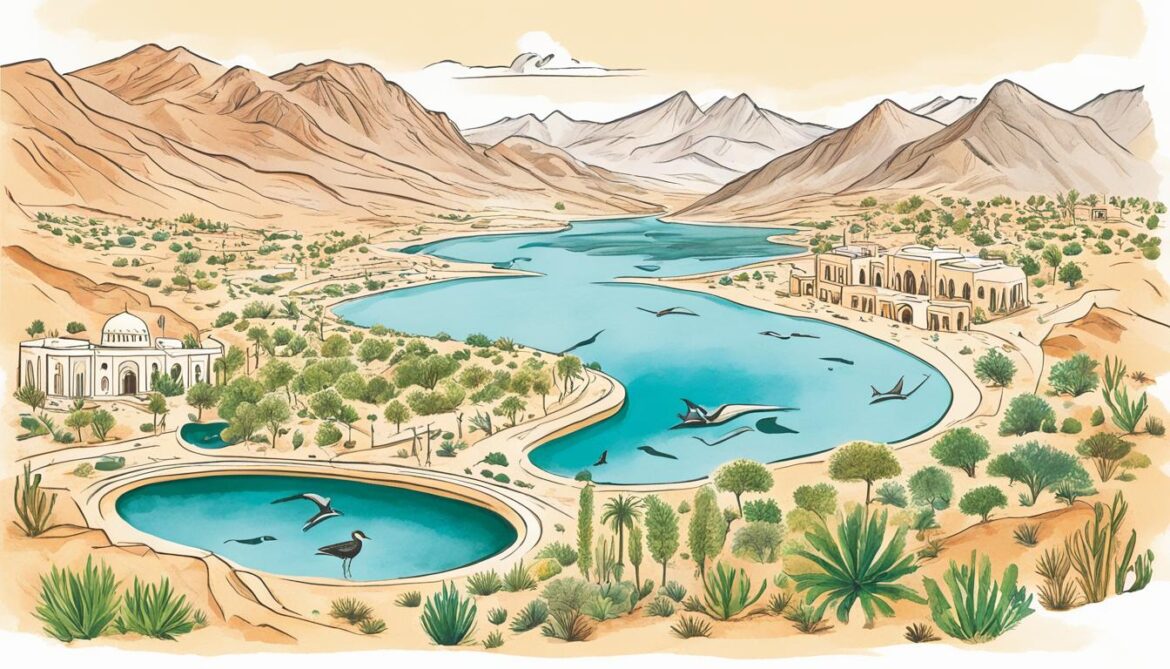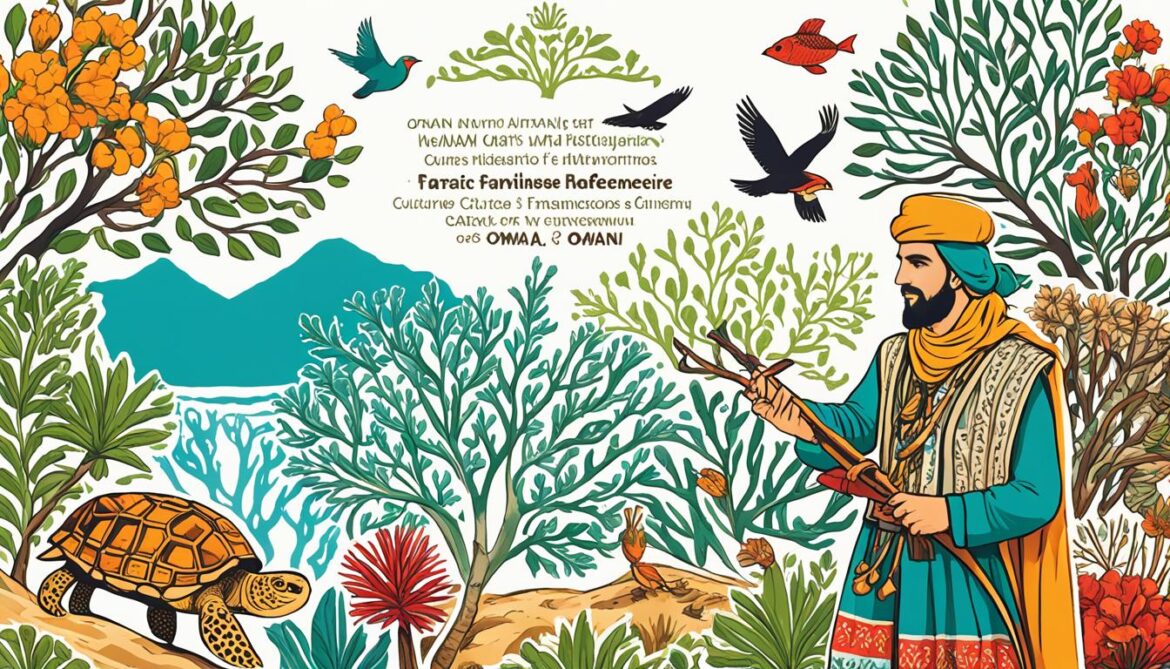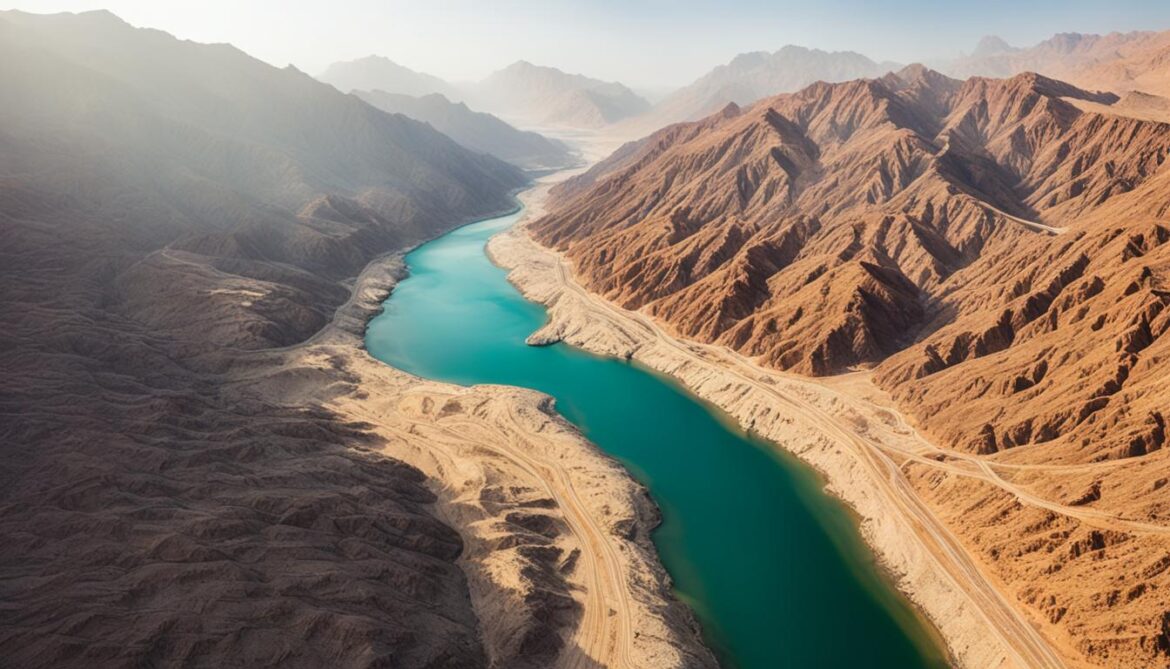Oman Sacred Natural Sites and Biodiversity
Did you know that sacred natural sites have been instrumental in preserving biodiversity and cultural heritage in Oman? These sites, revered for their spiritual and cultural significance, play a vital role in protecting the country’s unique ecosystems. From nature reserves to eco-tourism initiatives, Oman is committed to the conservation of its natural sites and the sustainable development of its environment.
- Oman’s sacred natural sites hold significant biodiversity and cultural value.
- These sites contribute to the sustainable development of the country.
- Oman is actively working towards safeguarding its natural heritage through environmental preservation and eco-tourism.
- The preservation of sacred natural sites promotes the conservation of unique ecosystems.
- The interplay between spirituality, culture, and conservation is essential for the long-term preservation of Oman’s natural heritage.
The Role of Sacred Natural Sites in Biodiversity Conservation
Sacred natural sites have a vital function in biodiversity conservation. These sites hold great significance in the eyes of traditional societies, as they are associated with deities, spirits, and ancestral worship. The belief in divine retribution for harming nature within these sacred sites serves as a powerful motivator for conservation among these communities. By recognizing the cultural and spiritual value of these sites, we can effectively complement conventional protected areas and conservation efforts.
One of the key advantages of sacred natural sites is their restricted access. This limited entry results in less direct human impact and exploitation of natural resources. The reverence and respect shown towards these sites by local communities ensure a higher level of environmental integrity within their boundaries. Moreover, the cultural and spiritual practices associated with these sites often contribute to sustainable resource management, promoting the long-term conservation of biodiversity.
“Sacred natural sites offer a unique opportunity to align traditional worldviews with modern environmental practices.”
By integrating traditional cultural practices and modern conservation strategies, we can achieve a harmonious balance that preserves both the natural environment and the spiritual connections of the local communities. This holistic approach recognizes the importance of biodiversity conservation and the preservation of cultural heritage.
Sacred natural sites serve as a reminder of the interconnectedness of nature, culture, and spirituality. The recognition of these sites as valuable ecosystems contributes to the preservation of their unique biodiversity. Their conservation is not only essential for environmental sustainability but also plays a significant role in safeguarding cultural traditions and promoting sustainable development.
Exploitation of Natural Resources
The belief in the sacredness of these sites acts as a deterrent against the exploitation of natural resources. Local communities understand the value of preserving these sites as sacred spaces and recognize the consequences of damaging them. This intrinsic motivation for conservation helps protect the biodiversity within these areas and safeguards their ecological integrity for future generations.
Overall, sacred natural sites play a critical role in biodiversity conservation by combining traditional worldviews, environmental integrity, and the prevention of the exploitation of natural resources. Recognizing the cultural and spiritual significance of these sites enhances conservation efforts and fosters sustainable development.
Sacred Natural Sites in Asia
Asia is a region known for its rich cultural and ethnic diversity, housing a multitude of traditional worldviews and belief systems. Within this diverse tapestry, sacred natural sites hold significant importance. These sites can be found across various countries in Asia, including Bhutan, Cambodia, China, India, Indonesia, Iran, Japan, Kyrgyzstan, Laos, Myanmar, Nepal, Oman, and Thailand.
While many of these sacred natural sites are associated with animist traditions, there are also strong connections to other religious and spiritual practices such as Hinduism, Buddhism, shamanism, and pre-Islamic religions. These sites are spaces where people come to honor and connect with the natural world, receiving guidance and spiritual nourishment.
The cultural and spiritual aspects of these sacred natural sites make them not only fascinating subjects of study but also important areas for conservation. Recognizing and understanding the beliefs and practices associated with these sites are critical for developing effective conservation approaches.
The book “Sacred Natural Sites and Biodiversity Conservation in Asia” offers a comprehensive exploration of the cultural and spiritual aspects of these sacred natural sites, shedding light on their potential role in conservation efforts.
Conservation Approaches for Sacred Natural Sites
Conserving sacred natural sites requires a unique approach that respects and integrates traditional belief systems. It involves understanding the animist traditions, Hindu, Buddhist, shamanistic, and pre-Islamic religious practices that are intertwined with the preservation of these sites.
By involving local communities, spiritual leaders, and custodians, conservation efforts can tap into the wealth of traditional knowledge and cultural practices associated with these sites. This collaboration helps to strike a balance between conservation goals and respecting the spiritual integrity of these sacred places.
Ancient Wisdom and Modern Challenges
The wisdom held within these sacred natural sites can offer valuable insights into sustainable practices and environmental stewardship. The spiritual connection to nature and the understanding of the interconnectedness of all living beings can inform modern conservation initiatives.
As Asia faces the challenges of rapid development and modernization, these sacred natural sites can serve as a reminder of the importance of preserving our natural heritage. Balancing economic growth with environmental conservation becomes feasible by incorporating sustainable practices that are deeply rooted in cultural and spiritual values.
Collaborative efforts between conservationists, custodians, religious leaders, and policymakers can foster greater awareness and action towards the preservation of sacred natural sites in Asia.
Preserving Cultural Integrity and Biodiversity
The conservation of sacred natural sites goes beyond protecting natural biodiversity; it also safeguards cultural integrity. These sites are repositories of traditional practices, stories, and rituals that have been passed down through generations.
By recognizing and valuing the cultural significance of these sacred places, we can ensure the continuity of diverse cultural practices while simultaneously protecting the unique ecosystems intertwined with them.
The study of sacred natural sites in Asia offers a wealth of insights and opportunities for conservation. Finding common ground between traditional practices, spiritual beliefs, and scientific approaches creates a foundation for sustainable biodiversity conservation in the region.
| Country | Sacred Natural Sites |
|---|---|
| Bhutan | Tiger’s Nest Monastery, Paro |
| Cambodia | Angkor Wat, Siem Reap |
| China | Mount Kailash, Tibet |
| India | Varanasi, Uttar Pradesh |
| Indonesia | Borobudur Temple, Central Java |
| Iran | Persepolis, Fars Province |
| Japan | Mt. Fuji, Yamanashi Prefecture |
| Kyrgyzstan | Son-Kul Lake, Naryn |
| Laos | Kuang Si Waterfalls, Luang Prabang |
| Myanmar | Bagan, Mandalay Region |
| Nepal | Pashupatinath Temple, Kathmandu |
| Oman | Jebel Akhdar, Al Hajar Mountains |
| Thailand | Doi Suthep Temple, Chiang Mai |

Exploring and understanding the sacred natural sites in Asia is not just an academic pursuit; it is an invitation to embrace the rich cultural and spiritual heritage that lies within these sites. By valuing and conserving these sacred places, we can pave the way for a more sustainable future that respects the interconnectedness of all life forms.
Perspectives on the Conservation of Sacred Natural Sites
The conservation of sacred natural sites offers unique perspectives on environmental values and cultural practices. These sites hold ancient knowledge and wisdom passed down through generations, promoting environmental integrity through traditional practices.
The inclusion of spiritual leaders, custodians, and religious practitioners in conservation efforts is key to countering the threats posed by societal and economic changes. Their valuable insights and expertise can guide sustainable approaches that strike a balance between human needs and environmental preservation.
The governance of sacred sites is complex, with customary law and rule-making playing crucial roles. This ensures that the conservation efforts align with the cultural and spiritual significance of these sites, thus promoting the long-term sustainability of both the cultural heritage and the biodiversity they protect.
Conservation approaches for sacred natural sites are rooted in a deep understanding of environmental values and cultural practices. By recognizing the interconnectedness of nature and spirituality, conservationists can develop strategies that respect and preserve both aspects.
Traditional Knowledge and Customary Law
Traditional knowledge, passed down through generations, holds valuable insights into sustainable practices and the protection of ecosystems. By integrating this knowledge into conservation approaches, we can harness the wisdom of the past to safeguard the future.
Customary law, developed and enforced by local communities, plays a crucial role in governing sacred sites. This form of rule-making ensures that conservation efforts align with cultural traditions and beliefs, creating a sense of ownership and responsibility among the custodians.
Cultural Practices and Environmental Stewardship
Cultural practices associated with sacred natural sites promote environmental stewardship by instilling a deep respect and reverence for nature. These practices often involve rituals, ceremonies, and taboos that regulate human behavior within these sites, preventing overexploitation and promoting sustainable resource management.
By understanding and respecting these cultural practices, conservationists can foster collaborations that empower local communities to become active participants in safeguarding their sacred lands. This approach not only ensures the preservation of cultural heritage but also promotes the long-term conservation of biodiversity.
Policy and Legal Approaches for Sacred Natural Sites Conservation
Recognizing sacred natural sites in government policies and legal frameworks is crucial for their conservation. These sites hold immense cultural and spiritual significance and play a vital role in maintaining biodiversity. Integrating sacred sites into existing conservation frameworks requires careful consideration of various strategies and challenges.
Chapters in the book “Sacred Natural Sites and Biodiversity Conservation in Asia” delve into the complexities of incorporating these sites into conservation efforts. The book explores how governance of sacred natural sites often involves a combination of traditional customary law and modern legal approaches.
Understanding the legal frameworks is essential, as it enables policymakers and conservationists to create effective strategies for the protection and preservation of sacred sites. Involving local communities, custodians, and religious leaders in the decision-making process is crucial for ensuring the successful conservation of these sites.
Integrating sacred natural sites into legal frameworks and policies allows for the recognition and protection of their cultural, spiritual, and ecological value. It empowers local communities and religious leaders to contribute actively to conservation efforts, fostering a sense of ownership and responsibility.
Conservation Challenges and Governance
The governance of sacred sites requires a delicate balance between customary law and modern legal frameworks. Customary law, shaped by generations of cultural practices and traditions, provides a foundation for preserving and protecting sacred natural sites. It offers guidance for proper management and sustainable use of these sites.
However, the governance of sacred natural sites also requires the integration of modern legal approaches. This helps address emerging challenges and enhances the effectiveness of conservation efforts. Finding a harmonious balance between customary law and modern legal frameworks ensures that sacred sites are safeguarded for future generations.
Government Policies and National Perspectives
Government policies play a crucial role in recognizing the importance of sacred natural sites and integrating them into conservation strategies. National perspectives vary, and it is essential for governments to consider the cultural, spiritual, and ecological importance of these sites within their unique contexts.
By incorporating sacred natural sites into national policies, governments demonstrate their commitment to cultural heritage preservation, sustainable development, and biodiversity conservation. This recognition brings attention to the need for their protection and ensures that future development plans consider their ecological sensitivities.
Legal Frameworks and Governance
Developing legal frameworks that acknowledge the value of sacred natural sites requires collaboration between governments, local communities, religious leaders, and conservation organizations. This collaborative approach ensures that the legal frameworks are inclusive, representative, and responsive to the needs of all stakeholders.
Conservation governance mechanisms should be designed to facilitate effective decision-making and protection of sacred natural sites. This involves creating appropriate laws, regulations, and policies that respect and uphold the spiritual and cultural integrity of these sites.
Furthermore, legal frameworks should provide clear guidelines for the sustainable management, monitoring, and enforcement of conservation efforts. They should encourage the participation of local communities and foster a sense of shared responsibility for the protection of sacred natural sites.
By integrating legal frameworks and governance mechanisms, governments can strengthen their commitment to the conservation of sacred natural sites, ensuring their long-term sustainability.

Comparative Analysis of Conservation Approaches
| Conservation Approach | National Perspectives | Government Policies | Legal Frameworks | Governance | Customary Law |
|---|---|---|---|---|---|
| Oman | Recognizes the cultural and ecological significance of sacred natural sites. | Incorporates sacred sites into national policies and development plans. | Develops legal frameworks for the protection and preservation of sacred sites. | Involves local communities and religious leaders in decision-making processes. | Combines customary law with modern legal approaches for governance. |
| India | Considers sacred sites as an integral part of cultural heritage. | Includes sacred natural sites in national policies and initiatives. | Establishes legal frameworks for the protection and management of sacred sites. | Forms governing bodies with representation from local communities and spiritual leaders. | Recognizes customary law in the governance and management of sacred natural sites. |
| Indonesia | Values the spiritual and ecological significance of sacred sites. | Incorporates sacred sites into national cultural preservation programs. | Enacts laws and regulations to protect and manage sacred sites. | Establishes collaborative governance structures involving local communities and religious leaders. | Respects customary law and traditional decision-making processes in site management. |
| Thailand | Recognizes the cultural and environmental value of sacred sites. | Includes sacred sites in government initiatives for cultural preservation. | Enacts legal frameworks for the conservation and maintenance of sacred sites. | Establishes committees and boards comprising diverse stakeholders to govern sacred sites. | Considers customary law in the management and protection of sacred natural sites. |
Sacred Natural Sites as a Tool for Sustainable Development
In many Asian countries, rapid economic development and modernization pose significant challenges to conservation efforts. However, sacred natural sites offer the potential for integrating sustainable practices into development plans.
By recognizing the cultural and ecological significance of these sites, policymakers and developers can strike a balance between conservation and sustainable development, ensuring the long-term well-being of both nature and communities.
The book “Sacred Natural Sites and Biodiversity Conservation in Asia” explores several case studies that highlight the role of sacred lands in meeting the challenges posed by economic development.
“Sacred natural sites are not just places of cultural and spiritual importance; they also hold immense potential for addressing conservation challenges in the face of rapid modernization.”
Preserving Cultural and Ecological Significance
By acknowledging the unique value of sacred natural sites, policymakers can incorporate sustainable practices that respect both cultural heritage and biodiversity. This approach fosters environmental stewardship and ensures the long-term preservation of these sites.
Striking a Balance
Developers, in collaboration with local communities and conservationists, can work towards integrating sustainable practices into their projects while protecting the sacredness of the land.
Case Studies
The book showcases numerous case studies that demonstrate how sacred natural sites can be successfully integrated into sustainable development plans:
- An eco-lodge built in harmony with the surroundings, using renewable energy sources to minimize ecological impact.
- Agricultural practices that respect traditional knowledge and incorporate sustainable farming techniques.
- Community-led initiatives that promote eco-tourism and generate income while preserving the cultural and ecological integrity of sacred sites.
The Path to Sustainable Development
Recognizing the role of sacred natural sites as a tool for sustainable development is essential. By incorporating traditional practices, respecting cultural values, and implementing sustainable practices, we can navigate the challenges posed by economic development while ensuring a harmonious coexistence between nature and human communities.

The Role of Custodians and Religious Leaders in Conservation
Spiritual guides and religious leaders have a vital part to play in supporting conservation efforts and mitigating threats to sacred natural sites. Their influence and authority can help advocate for environmental stewardship and cultivate a deeper affinity with the natural world.
By emphasising the importance of environmental preservation within their sacred places, custodians and religious leaders can inspire communities to protect and conserve the ecosystems on which these sites depend. Through their teachings and guidance, these influential figures can instill a sense of responsibility and reverence for the natural environment, fostering a harmonious relationship between humans and nature.
“Nature is not a place to visit. It is home.” – Gary Snyder
“The Earth does not belong to us. We belong to the Earth.” – Chief Seattle
Collaborative partnerships between conservationists and religious leaders can lead to more effective and sustainable conservation practices. By leveraging the wisdom and insights of spiritual guides and religious leaders, conservation initiatives can tap into the deep-rooted values and belief systems that underpin many communities’ relationships with nature.
Threats to Conservation
As custodians of sacred natural sites, spiritual guides and religious leaders are acutely aware of the threats posed by environmental degradation and unsustainable practices. They can raise awareness about these threats, encouraging their followers to take action and adopt environmentally responsible behaviors.
- Noah: Prophet Noah preached about the consequences of the reckless destruction of nature, highlighting how unsustainable practices could lead to devastating consequences.
- St. Francis of Assisi: Revered for his devotion to nature, St. Francis of Assisi considered all creatures as his brothers and sisters, emphasizing the interconnectedness of all living beings.
- The Dalai Lama: The Dalai Lama has consistently advocated for environmental stewardship, recognizing the intrinsic value of nature and the importance of preserving it for future generations.
Environmental Stewardship
A sense of environmental stewardship and custodianship is deeply embedded in many religious teachings. By harnessing this inherent connection, spiritual guides and religious leaders can encourage their followers to adopt sustainable lifestyles and promote conservation efforts.
“Love the environment as you love yourself. Protect it, nurture it, and it will sustain you in return.” – Unknown
The Power of Faith
Faith can be a powerful motivator in driving conservation efforts. Many followers are more likely to respect and protect the natural world when it is framed within the context of their religious beliefs and teachings.
“Faith is walking face-first and full-speed into the dark. If we truly knew all the answers in advance as to the meaning of life and the nature of God and the destiny of our souls, our belief would not be a leap of faith, and it would not be a courageous act of humanity; it would just be… a prudent insurance policy.” – Elizabeth Gilbert
Spiritual guides and religious leaders can bridge the gap between theology and environmental science, encouraging their communities to see the preservation of nature as an integral part of their religious and spiritual practices.

| Threats to Conservation | Examples of Religious Leaders |
|---|---|
| Habitat destruction: Deforestation, land degradation, and urban development | Chief Arvol Looking Horse: As a spiritual leader of the Lakota, Dakota, and Nakota Nations, Chief Arvol Looking Horse has been a vocal advocate against environmentally destructive practices. |
| Poaching and illegal wildlife trade: Threats to biodiversity | Pope Francis: Pope Francis has repeatedly spoken out against poaching and the illegal wildlife trade, highlighting the need for responsible stewardship of the Earth’s resources. |
| Climate change: Rising temperatures, sea-level rise, and extreme weather events | Gyalwang Drukpa: Gyalwang Drukpa, the head of the Drukpa Lineage of Buddhism, has actively championed environmental conservation and sustainable practices, including efforts to combat climate change. |
Science and Spirituality: Foundations of Conservation
The conservation efforts in Asia are heavily influenced by the cultural, spiritual, and philosophical foundations of sacred natural sites. These sites hold immense significance in shaping conservation practices in the region. Notably, the book “Sacred Natural Sites and Biodiversity Conservation in Asia” provides enlightening case studies that explore the connections between these foundations and conservation strategies.
By revisiting the interplay between spirituality, culture, and traditional knowledge, as well as incorporating scientific research, conservationists can develop more holistic and effective approaches to preserving biodiversity. This integration of spiritual and scientific perspectives serves as a solid foundation for sustainable conservation strategies.
Embracing Cultural Diversity
Cultural diversity plays a pivotal role in shaping conservation efforts across Asia. Each sacred natural site embodies the unique cultural heritage and practices of the local communities. By embracing cultural diversity, conservationists can foster a deeper understanding and appreciation for the interconnectedness between nature and human spirituality.
Understanding the Spiritual Significance
Sacred natural sites hold deep spiritual meaning for many communities in Asia. These sites serve as a link between the physical world and the spiritual realm, often associated with deities, spirits, and ancestral worship. Recognizing the spiritual significance of these sites is crucial for developing effective conservation strategies that resonate with the local communities and their cultural beliefs.
| Foundations | Conservation Relevance |
|---|---|
| Cultural | Cultivating respect for diverse cultural practices and heritage |
| Spiritual | Fostering a deeper connection between nature and human spirituality |
| Philosophical | Integrating traditional wisdom and knowledge into conservation practices |
The recognition of these foundations allows conservationists to establish meaningful partnerships with local communities, custodians, and religious leaders. These collaborations enable the development of conservation strategies that account for the cultural diversity and spiritual beliefs of the communities living in and around these sacred natural sites.
“The intertwining of culture, spirituality, and science lays the groundwork for a truly holistic approach to conservation.”
– Dr. Maya Gupta, Environmental Researcher
By drawing on scientific research and incorporating traditional knowledge, conservation efforts become more nuanced and effective. Scientific research can provide a deeper understanding of the ecological importance of these sites, while traditional knowledge offers valuable insights into sustainable practices that have stood the test of time.
Combining cultural, spiritual, and scientific perspectives is essential to ensure the long-term preservation of both sacred natural sites and the biodiversity they harbor. By honoring and embracing the diverse cultural heritage of Asia, conservationists can pave the way for a future where nature conservation is deeply rooted in spirituality, cultural diversity, and scientific advancements.

Oman’s Sacred Natural Sites and Biodiversity Conservation
Oman is home to several sacred natural sites that hold significant biodiversity and cultural value. One prime example is the Ras Al Hadd Nature Reserve, with its ancient monument to the sea turtle. These sites in Oman exemplify the interconnectedness of nature, culture, and spirituality, creating a harmonious balance between environmental preservation and cultural heritage.
The preservation of Oman’s natural heritage is vital not only for biodiversity conservation but also for the sustainable development of the country. These sacred sites contribute to the conservation of Oman’s unique ecosystems and promote a deep respect for the natural world among both locals and visitors.

Conserving Oman’s Sacred Natural Sites
Oman recognizes the importance of safeguarding its sacred natural sites and has taken proactive measures to promote biodiversity conservation. Through eco-tourism initiatives, visitors have the opportunity to explore these sites while learning about the cultural significance they hold. This promotes a greater understanding and appreciation for both the natural and cultural heritage of Oman.
Environmental preservation is a key focus in Oman’s sustainable development efforts. By implementing effective conservation strategies and involving local communities, Oman aims to strike a balance between economic growth and the preservation of its sacred natural sites. This ensures the long-term well-being of both the environment and the communities that rely on it.
The Significance of Oman’s Sacred Natural Sites
Oman’s sacred natural sites hold immense cultural value, as they are deeply intertwined with the country’s history and traditions. These sites have been cherished by generations, serving as important gathering places for spiritual and cultural practices. They are often associated with ancient rituals, folklore, and legends, further enriching Oman’s cultural heritage.
“Oman’s sacred natural sites are not just physical places; they are living legacies of our ancestors, embodying the wisdom and spirituality of our culture. Preserving these sites is a testament to our commitment to sustainable development and the conservation of our natural and cultural heritage.”
Benefits of Biodiversity Conservation in Oman
Conserving Oman’s sacred natural sites has numerous benefits, both locally and globally. The preservation of these sites contributes to the protection of Oman’s rich biodiversity, including various plant and animal species. It also helps maintain healthy ecosystems, promoting ecological balance and resilience.
Additionally, the conservation of sacred natural sites helps promote eco-tourism in Oman, attracting visitors from around the world who are interested in experiencing the country’s unique cultural and natural heritage. This not only boosts the local economy but also raises awareness about the importance of environmental conservation.
| Benefits of Biodiversity Conservation in Oman | Benefits |
|---|---|
| Preservation of Oman’s rich biodiversity | Protects various plant and animal species |
| Maintenance of healthy ecosystems | Promotes ecological balance and resilience |
| Boost in eco-tourism | Attracts visitors interested in cultural and natural heritage |
| Raising awareness about environmental conservation | Highlights the importance of protecting natural resources |
Oman’s commitment to the conservation of its sacred natural sites reflects its dedication to sustainable development and the long-term preservation of its environmental and cultural treasures. By valuing and protecting these sites, Oman sets an inspiring example for the global community.
Conclusion
The conservation of sacred natural sites in Asia, including Oman, provides a unique opportunity to integrate cultural practices, spirituality, and biodiversity conservation. By recognizing the cultural and ecological significance of these sites, we can enhance conservation efforts and promote sustainable development.
The book “Sacred Natural Sites and Biodiversity Conservation in Asia” offers valuable insights into the importance of sacred natural sites in maintaining cultural integrity and preserving biodiversity. Through fostering collaboration between conservationists, custodians, religious leaders, and policymakers, we can ensure the long-term preservation of these sacred places for future generations.
Summary: Sacred natural sites play a crucial role in biodiversity conservation, with traditional societies in Asia attributing spiritual and cultural significance to these areas. The preservation of sacred natural sites is essential for promoting the conservation of biodiversity and the sustainability of cultural practices. Recommendations: To effectively conserve sacred natural sites, it is important to involve local communities, custodians, and religious leaders. Additionally, integrating sacred sites into government policies and legal frameworks can provide a solid foundation for their long-term protection and management.








